GATE CSE DBMS PYQ
| Q1➡ | GATE 2021 Set-1 Suppose a database system crashes again while recovering from a previous crash. Assume checkpointing is not done by the database either during the transactions or during recovery. Which of the following statements is/are correct? |
| i ➥ All the transactions that are already undone and redone will not be recovered again. |
| ii ➥ The same undo and redo list will be used while recovering again. |
| iii ➥ The database will become inconsistent. |
| iv ➥ The system cannot recover any further. |
Show Answer With Best Explanation
| More Discussion | Explanation On YouTube | Transaction management | Help-Line |
| Q2➡ | GATE 2021 Set-1 A relation r(A, B) in a relational database has 1200 tuples. The attribute A has integer values ranging from 6 to 20, and the attribute B has integer values ranging from 1 to 20. Assume that the attributes A and B are independently distributed.  |
Show Answer With Best Explanation
| More Discussion | Explanation On YouTube | Relational Database | Help-Line |
| Q3➡ | GATE 2021 Set-1 The following relation records the age of 500 employees of a company, where empNo (indicating the employee number) is the key: Consider the following relational algebra expression: What does the above expression generate? |
| i ➥ Employee numbers of only those employees whose age is more than the age of exactly one other employee |
| ii ➥ Employee numbers of all employees whose age is not the minimum. |
| iii ➥ Employee numbers of all employees whose age is the minimum. |
| iv ➥ Employee numbers of only those employees whose age is the maximum. |
Show Answer With Best Explanation
| More Discussion | Explanation On YouTube | Relational Algebra | Help-Line |
| Q4➡ | GATE 2021 Set-1 Let ri(z) and wi(z) denote read and write operations respectively on a data item z by a transaction Ti. Consider the following two schedules. S1: r1(x) r1(y) r2(x) r2(y) w2(y) w1(x) S2: r1(x) r2(x) r2(y) w2(y) r1(y) w1(x) Which one of the following options is correct? |
| i ➥ Both S1 and S2 are conflict serializable. |
| ii ➥ Neither S1 nor S2 is conflict serializable. |
| iii ➥ S1 is conflict serializable, and S2 is not conflict serializable. |
| iv ➥ S1 is not conflict serializable, and S2 is conflict serializable. |
Show Answer With Best Explanation
| More Discussion | Explanation On YouTube | Transaction management | Help-Line |
| Q5➡ | GATE 2021 Set-1 Consider the relation R(P, Q, S, T, X, Y, Z, W) with the following functional dependencies  Consider the decomposition of the relation R into the consistent relations according to the following two decomposition schemes. D1: R=[(P,Q,S,T); (P,T,X); (Q,Y); (Y,Z,W)] D2: R=[(P,Q,S);(T,X);(Q,Y);(Y,Z,W)] Which one of the following options is correct? |
| i ➥ Both D1 and D2are lossy decompositions. |
| ii ➥ D1 is a lossless decomposition, but D2 is a lossy decomposition. |
| iii ➥ D1 is a lossy decomposition, but D2 is a lossless decomposition. |
| iv ➥ Both D1 and D2 are lossless decompositions. |
Show Answer With Best Explanation
| More Discussion | Explanation On YouTube | Normalization | Help-Line |
| Q6➡ | GATE 2021 Set-2 Consider the following statements S1 and S2 about the relational data model: S1: A relation scheme can have at most one foreign key. S2: A foreign key in a relation schema R cannot be used to refer to tuples of R. Which one of the following choices is correct? |
| i ➥ Both S1 and S2 are false. |
| ii ➥ S1 is false and S2 is true. |
| iii ➥ S1 is true and S2 is false. |
| iv ➥ Both S1 and S2 are true. |
Show Answer With Best Explanation
| More Discussion | Explanation On YouTube | Relational Model | Help-Line |
| Q7➡ | GATE 2021 Set-2 A data consisting of 1,50,000 student-records is stored on a hard disk with block size of 4096 bytes. The data file is sorted on the primary key RollNo. The size of a record pointer for this disk is 7 bytes. Each student-record has a candidate key attribute called ANum of size 12 bytes. Suppose an index file with records consisting of two fields, ANum value and the record pointer to the corresponding student record, is built and stored on the same disk. Assume that the records of data file and index file are not split across disk blocks. The number of blocks in the index file is _______. |
Show Answer With Best Explanation
| More Discussion | Explanation On YouTube | File Structure | Help-Line |
| Q8➡ | GATE 2021 Set-2 Let S be the following schedule of operations of three transactions T1, T2 and T3 in a relational database system: R2(Y), R1(X), R3(Z), R1(Y), W1(X), R2(Z), W2(Y), R3(X), W3(Z) Consider the statements P and Q below: P: S is conflict-serializable. Q: If T3 commits before T1 finishes, then S is recoverable. Which one of the following choices is correct? |
| i ➥ P is false and Q is true. |
| ii ➥ Both P and Q are false. |
| iii ➥ P is true and Q is false. |
| iv ➥ Both P and Q are true. |
Show Answer With Best Explanation
| More Discussion | Explanation On YouTube | Transaction Management | Help-Line |
| Q9➡ | GATE 2021 Set-2 The relation scheme given below is used to store information about the employees of a company, where empId is the key and deptId indicates the department to which the employee is assigned. Each employee is assigned to exactly one department. emp(empId, name, gender, salary, deptId) Consider the following SQL query: select deptId, count (*) from emp where gender = “female” and salary > (select avg(salary) from emp) group by deptId; The above query gives, for each department in the company, the number of female employees whose salary is greater than the average salary of |
| i ➥ female employees in the department |
| ii ➥ employees in the company |
| iii ➥ employees in the department |
| iv ➥ female employees in the company |
Show Answer With Best Explanation
| More Discussion | Explanation On YouTube | SQL | Help-Line |
| Q10➡ | GATE 2021 Set-2 Suppose the following functional dependencies hold on a relation U with attributes P, Q, R, S, and T: P⟶ QR RS⟶ T Which of the following functional dependencies can be inferred from the above functional dependencies? |
| i ➥ R ⟶ T |
| ii ➥ PS ⟶ Q |
| iii ➥ P ⟶ R |
| iv ➥ PS ⟶ T |
Show Answer With Best Explanation
| More Discussion | Explanation On YouTube | Normalization | Help-Line |
| Q11➡ | GATE 2020 Which one of the following is used to represent the supporting many-one relationships of a weak entity set in an entity-relationship diagram? |
| i ➥ Diamonds with double/bold border |
| ii ➥ Ovals with double/bold border |
| iii ➥ Ovals that contain underlined identifiers |
| iv ➥ Rectangles with double/bold border |
Show Answer With Best Explanation
| More Discussion | Explanation On YouTube | ER Model | Help-Line |
| Q12➡ | GATE 2020 Consider a relational database containing the following schemas. The primary key of each table is indicated by underlying the constituent fields.   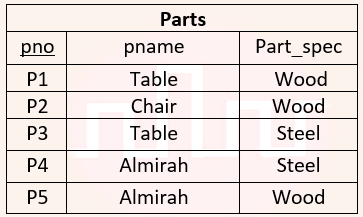 SELECT s.sno, s.sname FROM Suppliers s, Catalogue c WHERE s.sno = c.sno AND Cost > (SELECT AVG (cost) FROM Catalogue WHERE pno = ‘P4’ GROUP BY pno); The number of rows returned by the above SQL query is |
| i ➥ 2 |
| ii ➥ 0 |
| iii ➥ 4 |
| iv ➥ 5 |
Show Answer With Best Explanation
| More Discussion | Explanation On YouTube | SQL | Help-Line |
| Q13➡ | GATE 2020 Consider a schedule of transactions T1 and T2:  Here, RX stands for “Read(X)” and WX stands for “Write(X)”. Which one of the following schedules is conflict equivalent to the above schedule? |
i ➥  |
ii ➥  |
iii ➥  |
iv ➥  |
Show Answer With Best Explanation
| More Discussion | Explanation On YouTube | Transaction Management | Help-Line |
| Q14➡ | GATE 2020 Consider a relational table R that is in 3NF, but not in BCNF. Which one of the following statements is TRUE? |
| i ➥ R has a nontrivial functional dependency X→A, where X is not a superkey and A is a prime attribute. |
| ii ➥ R has a nontrivial functional dependency X→A, where X is not a superkey and A is a non-prime attribute and X is a proper subset of some key. |
| iii ➥ A cell in R holds a set instead of an atomic value. |
| iv ➥ R has a nontrivial functional dependency X→A, where X is not a superkey and A is a non-prime attribute and X is not a proper subset of any key. |
Show Answer With Best Explanation
| More Discussion | Explanation On YouTube | Normalization | Help-Line |
| Q15➡ | GATE 2020 Consider a database implemented using B+ tree for file indexing and installed on a disk drive with block size of 4 KB. The size of search key is 12 bytes and the size of tree/disk pointer is 8 bytes. Assume that the database has one million records. Also assume that no node of the B+ tree and no records are present initially in main memory. Consider that each record fits into one disk block. The minimum number of disk accesses required to retrieve any record in the database is ________. |
Show Answer With Best Explanation
| More Discussion | Explanation On YouTube | File Structue | Help-Line |
| Q16➡ | GATE 2019 Consider the following two statements about database transaction schedules: I. Strict two-phase locking protocol generates conflict serializable schedules that are also recoverable. II. Timestamp-ordering concurrency control protocol with Thomas Write Rule can generate view serializable schedules that are not conflict serializable. Which of the above statements is/are TRUE? |
| i ➥ II only |
| ii ➥ I only |
| iii ➥ Neither I nor II |
| iv ➥ Both I and II |
Show Answer With Best Explanation
| More Discussion | Explanation On YouTube | Transaction Management | Help-Line |
| Q17➡ | GATE 2019 Which one of the following statements is NOT correct about the B+ tree data structure used for creating an index of a relational database table? |
| i ➥ Non-leaf nodes have pointers to data records |
| ii ➥ B+ Tree is a height-balanced tree |
| iii ➥ Each leaf node has a pointer to the next leaf node |
| iv ➥ Key values in each node are kept in sorted order |
Show Answer With Best Explanation
| More Discussion | Explanation On YouTube | File Structures | Help-Line |
| Q18➡ | GATE 2019 Let the set of functional dependencies F = {QR → S, R → P, S → Q} hold on a relation schema X = (PQRS). X is not in BCNF. Suppose X is decomposed into two schemas Y and Z, where Y = (PR) and Z = (QRS). Consider the two statements given below: I. Both Y and Z are in BCNF II. Decomposition of X into Y and Z is dependency preserving and lossless Which of the above statements is/are correct? |
| i ➥ Both I and II |
| ii ➥ I only |
| iii ➥ II only |
| iv ➥ Neither I nor II |
Show Answer With Best Explanation
| More Discussion | Explanation On YouTube | Normalization | Help-Line |
| Q19➡ | GATE 2019 Consider the following relations P(X,Y,Z), Q(X,Y,T) and R(Y,V).  How many tuples will be returned by the following relational algebra query?  |
Show Answer With Best Explanation
| More Discussion | Explanation On YouTube | Relational Algebra | Help-Line |
| Q20➡ | GATE 2019 A relational database contains two tables Student and Performance as shown below: 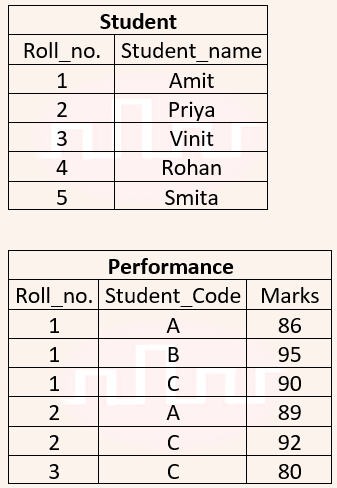 The primary key of the Student table is Roll_no. For the Performance table, the columns Roll_no. and Subject_code together from the primary key. Consider the SQL query given below: SELECT S.Student_name, sum (P.Marks) FROM Student S, Performance P WHERE P.Marks > 84 GROUP BY S.Student_name; The number of rows returned by the above SQL query is ________. |
Show Answer With Best Explanation
| More Discussion | Explanation On YouTube | SQL | Help-Line |
| Q21➡ | GATE 2018 In an Entity-Relationship (ER) model, suppose R is a many-to-one relationship from entity set E1 to entity set E2. Assume that E1 and E2 participate totally in R and that the cardinality of E1 is greater than the cardinality of E2. Which one of the following is true about R? |
| i ➥ Every entity in E1 is associated with exactly one entity in E2. |
| ii ➥ Some entity in E1 is associated with more than one entity in E2. |
| iii ➥ Every entity in E2 is associated with exactly one entity in E1. |
| iv ➥ Every entity in E2 is associated with at most one entity in E1. |
Show Answer With Best Explanation
| More Discussion | Explanation On YouTube | ER model | Help-Line |
| Q22➡ | GATE 2018 Consider the following four relational schemas. For each schema, all non-trivial functional dependencies are listed. The underlined attributes are the respective primary keys. Schema I: Registration(rollno, courses) Field ‘courses’ is a set-valued attribute containing the set of courses a student has registered for. Non-trivial functional dependency rollno → courses Schema II: Registration (rollno, courseid, email) Non-trivial functional dependencies: rollno, courseid → email email → rollno Schema III: Registration (rollno, courseid, marks, grade) Non-trivial functional dependencies: rollno, courseid, → marks, grade marks → grade Schema IV: Registration (rollno, courseid, credit) Non-trivial functional dependencies: rollno, courseid → credit courseid → credit Which one of the relational schemas above is in 3NF but not in BCNF? |
| i ➥ Schema I |
| ii ➥ Schema II |
| iii ➥ Schema III |
| iv ➥ Schema IV |
Show Answer With Best Explanation
| More Discussion | Explanation On YouTube | Normalization | Help-Line |
| Q23➡ | GATE 2018 Consider the relations r(A, B) and s(B, C), where s.B is a primary key and r.B is a foreign key referencing s.B. Consider the query Q: r ⋈ (σB<5 (s)) Let LOJ denote the natural left outer-join operation. Assume that r and s contain no null values. Which one of the following is NOT equivalent to Q? |
| i ➥ σB<5 (r ⨝ s) |
| ii ➥ σB<5 (r LOJ s) |
| iii ➥ r LOJ (σB<5(s)) |
| iv ➥ σB<5(r) LOJ s |
Show Answer With Best Explanation
| More Discussion | Explanation On YouTube | Relational Algebra | Help-Line |
| Q24➡ | GATE 2017 Set-1 The following functional dependencies hold true for the relational schema {V, W, X, Y, Z} : • V → W • VW → X • Y → VX • Y → Z Which of the following is irreducible equivalent for this set of functional dependencies? |
| i ➥ V→W W→X Y→V Y→Z |
| ii ➥ V→W W→X Y→V Y→X Y→Z |
| iii ➥ V→W V→X Y→V Y→Z |
| iv ➥ V→W V→X Y→V Y→X Y→Z |
Show Answer With Best Explanation
| More Discussion | Explanation On YouTube | Functional Dependency | Help-Line |
| Q25➡ | GATE 2017 Set-1 Consider a database that has the relation schema EMP (EmpId, EmpName, and DeptName). An instance of the schema EMP and a SQL query on it are given below: 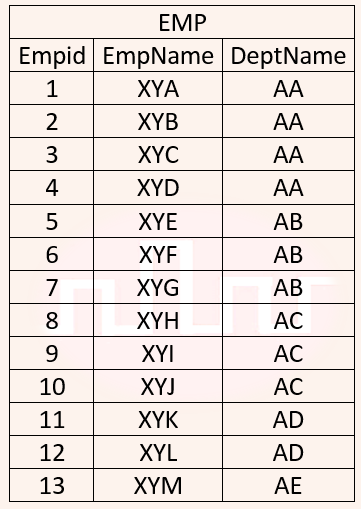 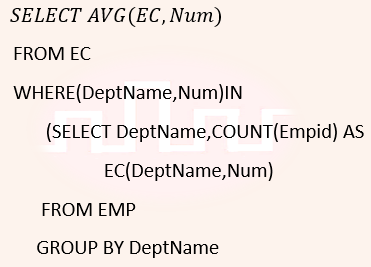 The output of executing the SQL query is __________. |
Show Answer With Best Explanation
| More Discussion | Explanation On YouTube | SQL | Help-Line |
| Q26➡ | GATE 2017 Set-1 In a database system, unique timestamps are assigned to each transaction using Lamport’s logical clock. Let TS(T1) and TS(T2) be the timestamps of transactions T1 and T2 respectively. Besides, T1 holds a lock on the resource R and T2 has requested a conflicting lock on the same resource R. The following algorithm is used to prevent deadlocks in the database system assuming that a killed transaction is restarted with the same timestamp. if TS(T2)<TS(T1) then T1 is killed else T2 waits. Assume any transaction that is not killed terminates eventually. Which of the following is TRUE about the database system that uses the above algorithm to prevent deadlocks? |
| i ➥ The database system is deadlock-free, but not starvation-free. |
| ii ➥ The database system is starvation-free, but not deadlock-free. |
| iii ➥ The database system is neither deadlock-free nor starvation-free. |
| iv ➥ The database system is both deadlock-free and starvation-free. |
Show Answer With Best Explanation
| More Discussion | Explanation On YouTube | Transaction Management | Help-Line |
| Q27➡ | GATE 2017 Set-1 Consider a database that has the relation schemas EMP(EmpId, EmpName, DeptId), and DEPT(DeptName, DeptId). Note that the DeptId can be permitted to a NULL in the relation EMP. Consider the following queries on the database expressed in tuple relational calculus. (I) {t│∃u ∈ EMP(t[EmpName] = u[EmpName] ∧ ∀v ∈ DEPT(t[DeptId] ≠ v[DeptId]))} (II) {t│∃u ∈ EMP(t[EmpName] = u[EmpName] ∧ ∃v ∈ DEPT(t[DeptId] ≠ v[DeptId]))} (III) {t│∃u ∈ EMP(t[EmpName] = u[EmpName] ∧ ∃v ∈ DEPT(t[DeptId] = v[DeptId]))} Which of the above queries are safe? |
| i ➥ (I), (II) and (III) |
| ii ➥ (I) and (III) only |
| iii ➥ (I) and (II) only |
| iv ➥ (II) and (III) only |
Show Answer With Best Explanation
| More Discussion | Explanation On YouTube | Relational Algebra | Help-Line |
| Q28➡ | GATE 2017 Set-1 Consider a database that has the relation schema CR(StudentName, CourseName). An instance of the schema CR is as given below: 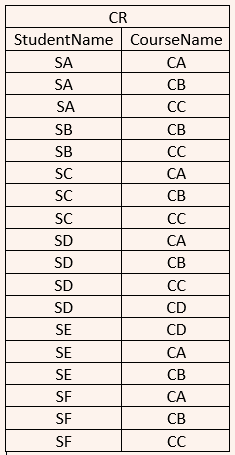 The following query is made on the database. T1 ← πCourseName(σStudentName=’SA’(CR)) T2 ← CR ÷ T1 The number of rows in T2 is _________. |
Show Answer With Best Explanation
| More Discussion | Explanation On YouTube | Relational Algebra | Help-Line |
| Q29➡ | GATE 2017 Set-2 An ER model of a database consists of entity types A and B. These are connected by a relationship R which does not have its own attribute. Under which one of the following conditions, can the relational table for R be merged with that of A? |
| i ➥ Relationship R is one-to-many and the participation of A in R is partial. |
| ii ➥ Relationship R is many-to-one and the participation of A in R is total. |
| iii ➥ Relationship R is one-to-many and the participation of A in R is partial. |
| iv ➥ Relationship R is one-to-many and the participation of A in R is total. |
Show Answer With Best Explanation
| More Discussion | Explanation On YouTube | ER Model | Help-Line |
| Q30➡ | GATE 2017 Set-2 Consider the following tables T1 and T2. 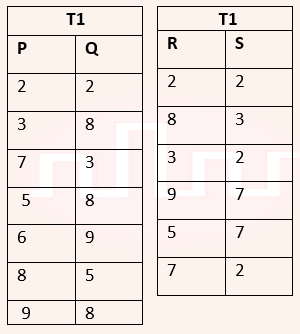 In table T1, P is the primary key and Q is the foreign key referencing R in table T2 with on-delete cascade and on-update cascade. In table T2, R is the primary key and S is the foreign key referencing P in table T1 with on-delete set NULL and on-update cascade. In order to delete record 〈3,8〉 from table T1, the number of additional records that need to be deleted from table T1 is ______. |
Show Answer With Best Explanation
| More Discussion | Explanation On YouTube | Referential Integrity | Help-Line |
| Q31➡ | GATE 2017 Set-2 Two transactions T1 and T2 are given as • T1: r1(X) w1(X) r1(Y) w1(Y) • T2: r2(Y) w2(Y) r2(Z) w2(Z) where ri(V) denotes a read operation by transaction Ti on a variable V and wi(V) denotes a write operation by transaction Ti on a variable V. The total number of conflict serializable schedules that can be formed by T1 and T2 is _______. |
Show Answer With Best Explanation
| More Discussion | Explanation On YouTube | Transaction Management | Help-Line |
| Q32➡ | GATE 2017 Set-2 In a B+ tree, if the search-key value is 8 bytes long, the block size is 512 bytes and the block pointer size is 2 bytes, then the maximum order of the B+ tree is ________. |
Show Answer With Best Explanation
| More Discussion | Explanation On YouTube | File Structure | Help-Line |
| Q33➡ | GATE 2016 Set-1 Which of the following is NOT a superkey in a relational schema with attributes V, W, X, Y, Z and primary key VY? |
| i ➥ VWXYZ |
| ii ➥ VWXY |
| iii ➥ VWXZ |
| iv ➥ VXYZ |
Show Answer With Best Explanation
| More Discussion | Explanation On YouTube | Normalization | Help-Line |
| Q34➡ | GATE 2016 Set-1 Which of the following is NOT a part of the ACID properties of database transactions? |
| i ➥ Deadlock-freedom |
| ii ➥ Isolation |
| iii ➥ Consistency |
| iv ➥ Atomicity |
Show Answer With Best Explanation
| More Discussion | Explanation On YouTube | Transaction Managemnt | Help-Line |
| Q35➡ | GATE 2016 Set-1 A database of research articles in a journal uses the following schema. (VOLUME, NUMBER, STARTPAGE, ENDPAGE, TITLE, YEAR, PRICE) The primary key is (VOLUME, NUMBER, STARTPAGE, ENDPAGE) and the following functional dependencies exist in the schema. • (VOLUME, NUMBER, STARTPAGE, ENDPAGE) → TITLE • (VOLUME, NUMBER) → YEAR • (VOLUME, NUMBER, STARTPAGE, ENDPAGE) → PRICE The database is redesigned to use the following schemas. • (VOLUME, NUMBER, STARTPAGE, ENDPAGE, TITLE, PRICE) (VOLUME, NUMBER, YEAR) Which is the weakest normal form that the new database satisfies, but the old one does not? |
| i ➥ BCNF |
| ii ➥ 3NF |
| iii ➥ 2NF |
| iv ➥ 1NF |
Show Answer With Best Explanation
| More Discussion | Explanation On YouTube | Normalization | Help-Line |
| Q36➡ | GATE 2016 Set-1 Consider the following two phase locking protocol. Suppose a transaction T accesses (for read or write operations), a certain set of objects{O1,…,Ok}. This is done in the following manner: Step1: T acquires exclusive locks to O1,…,Ok in increasing order of their addresses. Step2: The required operations are performed. Step3: All locks are released. This protocol will |
| i ➥ guarantee serializability and deadlock-freedom |
| ii ➥ guarantee neither serializability nor deadlock-freedom |
| iii ➥ guarantee serializability but not deadlock-freedom |
| iv ➥ guarantee deadlock-freedom but not serializability |
Show Answer With Best Explanation
| More Discussion | Explanation On YouTube | Transaction Management | Help-Line |
| Q37➡ | GATE 2016 Set-1 B+ Trees are considered BALANCED because |
| i ➥ The number of records in any two leaf nodes differ by at most 1. |
| ii ➥ The number of children of any two non-leaf sibling nodes differ by at most 1. |
| iii ➥ The lengths of the paths from the root to all leaf nodes differ from each other by at most 1. |
| iv ➥ The lengths of the paths from the root to all leaf nodes are all equal. |
Show Answer With Best Explanation
| More Discussion | Explanation On YouTube | File Structure | Help-Line |
| Q38➡ | GATE 2016 Set-1 Suppose a database schedule S involves transactions T1, …, Tn. Construct the precedence graph of S with vertices representing the transactions and edges representing the conflicts. If S is serializable, which one of the following orderings of the vertices of the precedence graph is guaranteed to yield a serial schedule? |
| i ➥ Ascending order of transaction indices |
| ii ➥ Breadth-first order |
| iii ➥ Depth-first order |
| iv ➥ Topological order |
Show Answer With Best Explanation
| More Discussion | Explanation On YouTube | Transaction Managemnt | Help-Line |
| Q39➡ | GATE 2016 Set-1 Consider the following database schedule with two transactions, T1 and T2. • S = r2(X); r1(X); r2(Y); w1(X); r1(Y); w2(X); a1; a2 where ri(Z) denotes a read operation by transaction Ti on a variable Z, wi(Z) denotes a write operation by Ti on a variable Z and ai denotes an abort by transaction Ti. Which one of the following statements about the above schedule is TRUE? |
| i ➥ S is non-recoverable |
| ii ➥ S is recoverable, but has a cascading abort |
| iii ➥ S does not have a cascading abort |
| iv ➥ S is strict |
Show Answer With Best Explanation
| More Discussion | Explanation On YouTube | Transaction Management | Help-Line |
| Q40➡ | GATE 2016 Set-1 Consider the following database table named water_schemes : 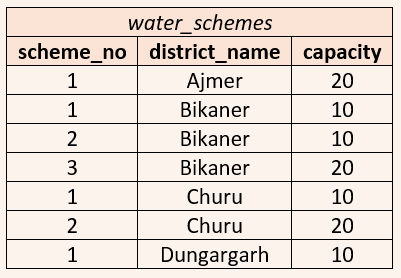 The number of tuples returned by the following SQL query is ___________. 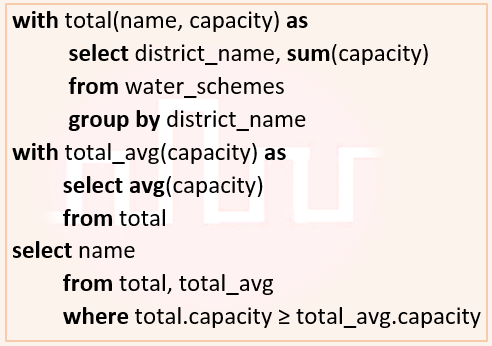 |
Show Answer With Best Explanation
| More Discussion | Explanation On YouTube | SQL | Help-Line |
| Q41➡ | GATE 2015 Set-1 SELECT operation in SQL is equivalent to |
| i ➥ The selection operation in relational algebra |
| ii ➥ The selection operation in relational algebra, except that SELECT in SQL retains duplicates |
| iii ➥ The projection operation in relational algebra |
| iv ➥ The projection operation in relational algebra, except that SELECT in SQL retains duplicates |
Show Answer With Best Explanation
| More Discussion | Explanation On YouTube | SQL | Help-Line |
| Q42➡ | GATE 2015 Set-1 A file is organized so that the ordering of the data records is the same as or close to the ordering of data entries in some index. Than that index is called |
| i ➥ Dense |
| ii ➥ Sparse |
| iii ➥ Clustered |
| iv ➥ Unclustered |
Show Answer With Best Explanation
| More Discussion | Explanation On YouTube | File Structure | Help-Line |
| Q43➡ | GATE 2015 Set-1 Consider an Entity-Relationship (ER) model in which entity sets E1 and E2 are connected by an m:n relationship R12, E1 and E3 are connected by a 1:n (1 on the side of E1 and n on the side of E3) relationship R13. E1 has two single-valued attributes a11 and a12 of which a11 is the key attribute. E2 has two single-valued attributes a21 and a22 is the key attribute. E3 has two single-valued attributes a31 and a32 of which a31 is the key attribute. The relationships do not have any attributes. If a relational model is derived from the above ER model, then the minimum number of relations that would be generated if all the relations are in 3NF is __________. |
Show Answer With Best Explanation
| More Discussion | Explanation On YouTube | E-R Model | Help-Line |
| Q44➡ | GATE 2015 Set-1 Consider the following relations: 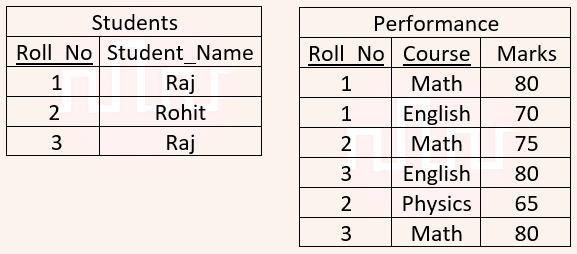 Consider the following SQL query. SELECT S. Student_Name, sum(P.Marks)The number of rows that will be returned by the SQL query is ______. |
Show Answer With Best Explanation
| More Discussion | Explanation On YouTube | SQL | Help-Line |
| Q45➡ | GATE 2015 Set-2 Consider the following transaction involving two bank account x and y. read(x); x:= x-50; write(x); read(y); y:= y+50; write(y) The constraint that the sum of the accounts x and y should remain constant is that of |
| i ➥ Atomicity |
| ii ➥ Consistency |
| iii ➥ Isolation |
| iv ➥ Durability |
Show Answer With Best Explanation
| More Discussion | Explanation On YouTube | Transaction Management | Help-Line |
| Q46➡ | GATE 2015 Set-2 With reference to the B+ tree index of order 1 shown below, the minimum number of nodes (including the Root node) that must be fetched in order to satisfy the following query:”Get all records with a search key grater than or equal to 7 and less than 15″ is _______. 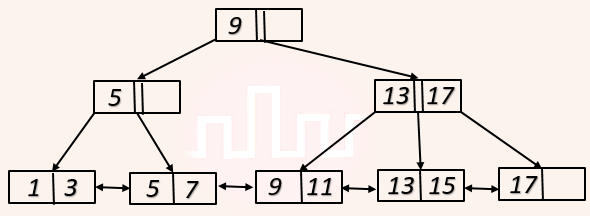 |
Show Answer With Best Explanation
| More Discussion | Explanation On YouTube | File Structure | Help-Line |
| Q47➡ | GATE 2015 Set-2 Consider a simple check-pointing protocol and the following set of operations in the log. (start, T4); (write, T4, y, 2, 3); (start, T1); (commit, T4); (write, T1, z, 5, 7); (checkpoint); (start, T2); (write, T2, x, 1, 9); (commit, T2); (start, T3); (write, T3, z, 7, 2); If a crash happens now and the system tries to recover using both undo and redo operations, what are the contents of the undo list and the redo list |
| i ➥ Undo T3, T1; Redo T2 |
| ii ➥ Undo T3, T1; Redo T2, T4 |
| iii ➥ Undo: none; redo: T2, T4, T3, T1 |
| iv ➥ Undo T3, T1; T4; Redo: T2 |
Show Answer With Best Explanation
| More Discussion | Explanation On YouTube | Transaction Management | Help-Line |
| Q48➡ | GATE 2015 Set-2 Consider two relations R1(A,B) with the tuples (1,5), (3,7) and R2(A,C) = (1,7), (4,9). Assume that R(A,B,C) is the full natural outer join of R1 and R2. Consider the following tuples of the form (A,B,C): a = (1.5,null), b = (1,null,7), c = (3,null,9), d = (4,7,null), e = (1,5,7), f = (3,7,null), g = (4,null,9). Which one of the following statements is correct? |
| i ➥ R contains a,b,e,f,g but not c, d. |
| ii ➥ R contains all of a,b,c,d,e,f,g |
| iii ➥ R contains e,f,g but not a,b |
| iv ➥ R contains e but not f,g |
Show Answer With Best Explanation
| More Discussion | Explanation On YouTube | Relational Algebra | Help-Line |
| Q49➡ | GATE 2015 Set-3 Consider the relation X(P, Q, R, S, T, U) with the following set of functional dependencies F = { {P, R} → {S,T}, {P, S, U} → {Q, R} } Which of the following is the trivial functional dependency in F+, Where F+ is closure of F? |
| i ➥ {P,R}→{S,T} |
| ii ➥ {P,R}→{R,T} |
| iii ➥ {P,S}→{S} |
| iv ➥ {P,S,U}→{Q} |
Show Answer With Best Explanation
| More Discussion | Explanation On YouTube | Functional Dependency | Help-Line |
| Q50➡ | |
